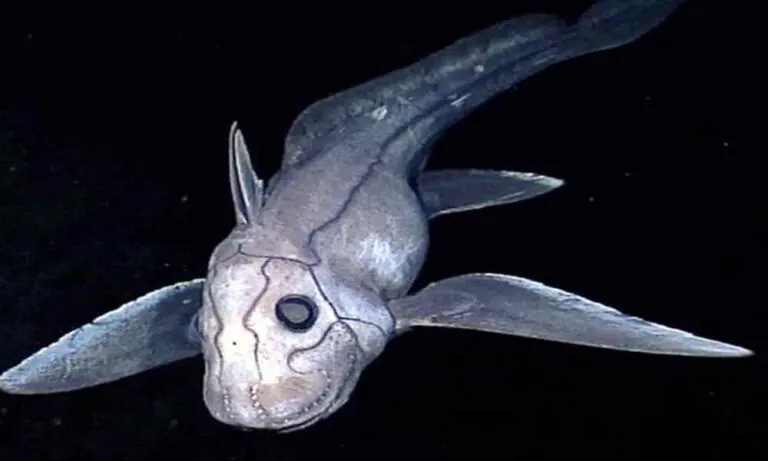World’s Largest Leatherback Sea Turtle with Scissor-Like Jaws Weighs Over a Ton!
World’s Largest Leatherback Sea Turtle
According to the Guinness World Record, the largest leatherback turtle ever recorded was a male found on the beach at Harlech, Gwynedd, in north-west Wales. Discovered on 23 September 1988, the leatherback measured up to 2.91 m (9 ft 6.56 in) in total length over the carapace, and 2.77 m (9 ft) across the front flippers. The turtle weighed over 961.1 kg (2,120 lb). Unfortunately, after breaking a record, he has now left the world.

Why We Call Them Leatherback Sea Turtles
Leatherback sea turtles are named after their soft backs. The lack of a hard shell sets them apart from other sea turtle species. Instead of a solid, bony covering, their backs have oily, rubber-like flesh, giving them their unique name. The structure of their bodies allows them to move more efficiently in the water and survive in deeper and colder waters. Leatherback turtles have the most hydrodynamic body that cannot be matched with any other sea turtle. The large teardrop-shaped body and the large pair of front flippers help the turtle power through the water.
Leatherbacks also can maintain a higher body temperature in cold water. This ability is due to their size and a layer of fat beneath their skin. Leatherbacks are the only sea turtle species with this warm-blooded adaptation, which allows them to live in a wide range of water temperatures. Rather than using a high resting metabolism, leatherbacks appear to take advantage of a high activity rate.
Studies on wild D. coriacea discovered that individual leatherback turtles only spend a mere few minutes resting per day. This constant swimming creates muscle-derived heat. Coupled with their countercurrent heat exchangers, insulating fat covering, and large size, leatherbacks can maintain high-temperature differentials compared to the surrounding water.
Leatherback Sea Turtles’ Global Distribution and Habitats
One can find leatherback sea turtles in every ocean except the Arctic and Antarctic. They have the largest distribution of all sea turtle species, with populations in the Atlantic, Pacific, and Indian Oceans. They prefer open ocean habitats but are also we find them near coastal waters, particularly during nesting season.
In the Pacific Ocean, leatherback sea turtles nest along the coasts of Indonesia, Malaysia, Papua New Guinea, and the Solomon Islands. In the Atlantic Ocean, we find the major nesting sites along the coasts of Central and South America, particularly in Suriname, French Guiana, and Trinidad. However, in the Indian Ocean, leatherback nesting sites are located in South Africa, Mozambique, and Sri Lanka.

Leatherback sea turtles are highly migratory. They can travel more than 10,000 miles (about 16000 km) in a year, following ocean currents in search of food. They prefer colder waters for feeding and warmer waters for nesting. This wide range of habitats helps them find sufficient food and safe places to lay their eggs.
Leatherback Sea Turtles’ Population and Subpopulations
We can divide the leatherback sea turtle populations into subpopulations based on geographic regions. There are two major populations in the Pacific Ocean, one in the western Pacific and the other in the eastern Pacific. There is also a distinct population in the Atlantic Ocean, as well as smaller subpopulations in the Indian Ocean.
Researchers consider the western Pacific subpopulation as one of the most stable, with nesting sites in Indonesia and Papua New Guinea. The eastern Pacific subpopulation, however, is critically endangered, with significant declines in nesting populations in Mexico and Costa Rica. Atlantic populations are generally more stable, although some nesting sites in the Caribbean are showing declines.

Despite their wide distribution, the International Union for Conservation of Nature (IUCN) lists leatherback sea turtles as vulnerable. Their populations are declining due to habitat loss, egg poaching, bycatch in fishing gear, and marine pollution. According to a report by the World Wildlife Fund (WWF), less than 100,000 female leatherbacks remain worldwide.
Feeding Habits
Leatherback sea turtles feed primarily on jellyfish. Their scissor-like jaws are perfectly adapted to catching and eating soft-bodied prey. Jellyfish are abundant in the open ocean, making them a readily available food source for leatherbacks. Their diet also includes other soft-bodied marine animals such as tunicates and salps.

Leatherback sea turtles are known for their ability to consume large amounts of jellyfish. According to the Sea Turtle Conservancy, a single adult leatherback can eat hundreds of pounds of jellyfish each day. This feeding behavior plays a crucial role in controlling jellyfish populations, which helps maintain the balance of marine ecosystems.
Leatherback sea turtles also ingest plastic debris, which they mistake for jellyfish. Ingesting plastic can cause blockages in their digestive systems, leading to injury or death. Marine pollution is one of the leading threats to leatherback sea turtles, and efforts to reduce plastic waste in the ocean are essential for their survival.
Leatherback Sea Turtles’ Mating and Nesting Behavior
Leatherback sea turtles reach sexual maturity at around 15 to 25. Mating occurs in the open ocean, with males rarely coming ashore. After mating, females return to nesting beaches, where they dig nests in the sand and lay their eggs. Nesting occurs every two to three years, with each female laying between 80 and 100 eggs per nest.
The nesting process begins at night, with the female using her flippers to dig a hole in the sand. Once the eggs are laid, she covers the nest with sand to protect them from predators. After an incubation period of about 60 days, the eggs hatch, and the hatchlings make their way to the sea. The survival rate of hatchlings is low, with only a small percentage reaching adulthood.
Nesting sites are critical for the survival of leatherback sea turtles. Coastal development, beach erosion, and climate change are all factors that threaten nesting habitats. In some areas, activists implemented conservation efforts to protect nesting beaches and reduce disturbances during the nesting season.

Migration Patterns
Leatherback sea turtles are known for their long migrations. After nesting, females return to the open ocean, where they embark on migrations that can cover thousands of miles. These migrations are driven by the need to find food and suitable nesting sites.
Satellite tracking has provided valuable insights into the migration patterns of leatherback sea turtles. Research conducted by the University of Exeter found that leatherbacks in the Atlantic Ocean migrate between tropical nesting sites and temperate feeding grounds. In the Pacific Ocean, leatherbacks travel between nesting beaches in Southeast Asia and feeding grounds off the coast of California.
Leatherback sea turtles rely on ocean currents to aid their migrations. They are strong swimmers and can travel at speeds of up to 22 miles per hour (35 km/h). Their ability to navigate vast ocean distances is still not fully understood, but it is believed that they use the Earth’s magnetic field as a guide.
Threats to Survival
Leatherback sea turtles face numerous threats to their survival. One of the most significant threats is bycatch, which occurs when turtles are accidentally caught in fishing gear. Longline fishing, trawl nets, and gillnets are particularly hazardous for leatherbacks. Bycatch is responsible for the deaths of thousands of leatherback sea turtles each year.
Marine pollution is another major threat. Leatherback sea turtles often mistake plastic debris for jellyfish, which can lead to ingestion and fatal blockages in their digestive systems. In addition, oil spills and chemical pollutants can contaminate their habitats, further endangering their populations.
Coastal development and habitat destruction also pose significant risks. Many nesting beaches are being lost due to beachfront construction, erosion, and rising sea levels. Climate change is affecting the temperature of nesting sites, which can influence the sex ratio of hatchlings, as warmer temperatures produce more females and cooler temperatures produce more males.
Conservation Efforts
Conservation organizations around the world are working to protect leatherback sea turtles and their habitats. Efforts include protecting nesting beaches, reducing bycatch in fisheries, and raising awareness about marine pollution. In some areas, hatcheries have been established to protect eggs from predators and human disturbances.
The Sea Turtle Conservancy has implemented satellite tracking programs to monitor leatherback migrations and identify key feeding and nesting areas. This information is used to create marine protected areas and inform conservation policies. In addition, public awareness campaigns aim to reduce plastic waste and promote sustainable fishing practices.
Conclusion
The largest leatherback sea turtles, with their unique scissor-like jaws and soft backs, are remarkable creatures. They play a vital role in marine ecosystems by controlling jellyfish populations and contributing to the health of ocean habitats. However, they face numerous threats, including bycatch, marine pollution, and habitat loss. Conservation efforts are crucial to ensuring the survival of these gentle giants, whose populations are rapidly declining.
Also Read
Penguinz0 Exposes Boogie2988’s Cancer Claims: The Full Controversy Explained







